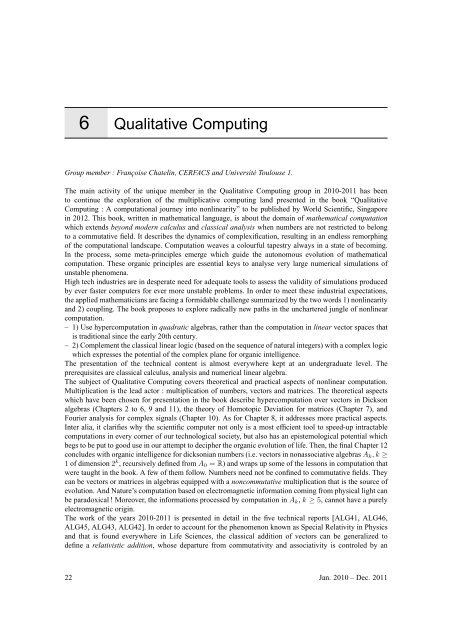CERFACS CERFACS Scientific Activity Report Jan. 2010 â Dec. 2011
CERFACS CERFACS Scientific Activity Report Jan. 2010 â Dec. 2011
CERFACS CERFACS Scientific Activity Report Jan. 2010 â Dec. 2011
You also want an ePaper? Increase the reach of your titles
YUMPU automatically turns print PDFs into web optimized ePapers that Google loves.
6 Qualitative Computing<br />
Group member : Françoise Chatelin, <strong>CERFACS</strong> and Université Toulouse 1.<br />
The main activity of the unique member in the Qualitative Computing group in <strong>2010</strong>-<strong>2011</strong> has been<br />
to continue the exploration of the multiplicative computing land presented in the book “Qualitative<br />
Computing : A computational journey into nonlinearity” to be published by World <strong>Scientific</strong>, Singapore<br />
in 2012. This book, written in mathematical language, is about the domain of mathematical computation<br />
which extends beyond modern calculus and classical analysis when numbers are not restricted to belong<br />
to a commutative field. It describes the dynamics of complexification, resulting in an endless remorphing<br />
of the computational landscape. Computation weaves a colourful tapestry always in a state of becoming.<br />
In the process, some meta-principles emerge which guide the autonomous evolution of mathematical<br />
computation. These organic principles are essential keys to analyse very large numerical simulations of<br />
unstable phenomena.<br />
High tech industries are in desperate need for adequate tools to assess the validity of simulations produced<br />
by ever faster computers for ever more unstable problems. In order to meet these industrial expectations,<br />
the applied mathematicians are facing a formidable challenge summarized by the two words 1) nonlinearity<br />
and 2) coupling. The book proposes to explore radically new paths in the unchartered jungle of nonlinear<br />
computation.<br />
– 1) Use hypercomputation in quadratic algebras, rather than the computation in linear vector spaces that<br />
is traditional since the early 20th century.<br />
– 2) Complement the classical linear logic (based on the sequence of natural integers) with a complex logic<br />
which expresses the potential of the complex plane for organic intelligence.<br />
The presentation of the technical content is almost everywhere kept at an undergraduate level. The<br />
prerequisites are classical calculus, analysis and numerical linear algebra.<br />
The subject of Qualitative Computing covers theoretical and practical aspects of nonlinear computation.<br />
Multiplication is the lead actor : multiplication of numbers, vectors and matrices. The theoretical aspects<br />
which have been chosen for presentation in the book describe hypercomputation over vectors in Dickson<br />
algebras (Chapters 2 to 6, 9 and 11), the theory of Homotopic Deviation for matrices (Chapter 7), and<br />
Fourier analysis for complex signals (Chapter 10). As for Chapter 8, it addresses more practical aspects.<br />
Inter alia, it clarifies why the scientific computer not only is a most efficient tool to speed-up intractable<br />
computations in every corner of our technological society, but also has an epistemological potential which<br />
begs to be put to good use in our attempt to decipher the organic evolution of life. Then, the final Chapter 12<br />
concludes with organic intelligence for dicksonian numbers (i.e. vectors in nonassociative algebras A k ,k ≥<br />
1 of dimension 2 k , recursively defined from A 0 = R) and wraps up some of the lessons in computation that<br />
were taught in the book. A few of them follow. Numbers need not be confined to commutative fields. They<br />
can be vectors or matrices in algebras equipped with a noncommutative multiplication that is the source of<br />
evolution. And Nature’s computation based on electromagnetic information coming from physical light can<br />
be paradoxical ! Moreover, the informations processed by computation in A k , k ≥ 5, cannot have a purely<br />
electromagnetic origin.<br />
The work of the years <strong>2010</strong>-<strong>2011</strong> is presented in detail in the five technical reports [ALG41, ALG46,<br />
ALG45, ALG43, ALG42]. In order to account for the phenomenon known as Special Relativity in Physics<br />
and that is found everywhere in Life Sciences, the classical addition of vectors can be generalized to<br />
define a relativistic addition, whose departure from commutativity and associativity is controled by an<br />
22 <strong>Jan</strong>. <strong>2010</strong> – <strong>Dec</strong>. <strong>2011</strong>
















